Beetles - Ladybirds
BEETLES - ALL
List of Ladybirds :
2 Spot ladybird
Adalia bipunctata
Date
19.07.2004
Sighting
Found on Fuschia in back garden.
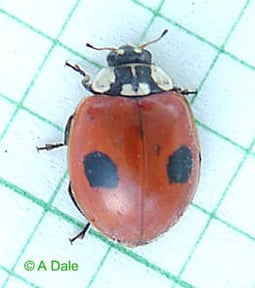

25.05.2005
On nettles on roadside ditch bank.
On hatching, the soft bodied larva feeds voraciously on aphids for about two to three weeks and goes through four intermediate larval stages to accomodate body growth before pupating. At each stage it can appear subtly different and, in the early stages, positive identification can be difficult.

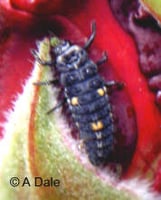
The third image illustrates the transition process from larva to pupa.

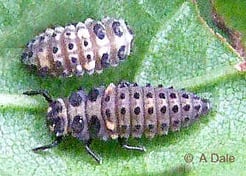
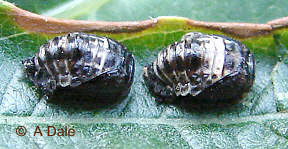

The larva becomes dull and slowly shrinks into the 'hunched up' form of the pupal state shown in the fourth image.
Over the course of six days, the pupal case becomes dull black and shriveled, before the transformed adult 2 spot ladybird emerges.
The new adult emerges full sized but, pale creamy brown colour in colour, with just the vaguest suggestion of dark spots and will take some 36 hours to attain normal coloration.

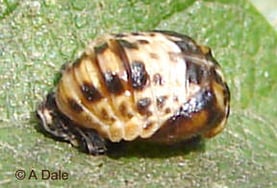
09.03.2006
Indoors and very active.
02.07.2006
Recently formed pupa found at Whisby Nature Reserve.
Adult emerged from pupal case and started feeding on aphids.
07.07.2006
06/08.09.2007
Two adults emerged two days apart from pupae found on willow behind Horncastle PO.
08.07.2012
Newly emerged adults released onto Silver Birch from whence the pupae came.
First of the year found on a sunny window frame.
12.03.2010
06.04.2009
Very active for first of year sighting.
At 5mm this is smaller than the more common 7 spot ladybird but, it is abundant throughout Europe and is often found in quite large groups hibernating through the winter in sheltered nooks and crannies.
It can be quite varied in its coloration. The image is representative of the red and orange forms.
The black form usually has a pure black 'pronotum', that's the area of the thorax just in front of the wing cases. But, just to confuse things, it can also have more than two spots! Four spot forms are not unusual.
Colour variation can be determined by both genetic and environmental factors.
The red forms are reputed to survive the winter better, whereas the black forms appear to have much better reproduction rates.
During this time it will be soft bodied, very vulnerable and will tend to seek a safe refuge so, it is not a state commonly seen.
2 spot, Kidney-spot ladybird
Chilocorus renipustulatus
At 5mm in length, I had originally assumed this to be the black form of the 2-spot ladybird but, expert opinion has pointed out that it is more representative of the Kidney-spot ladybird.
Date
01.09.2005
Sighting
Several found around the garden.
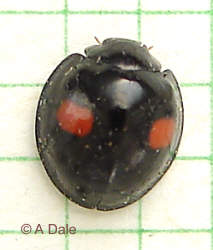

While the spots on this specimen do not appear particularly 'kidney shaped', they are 'within the normal variation' for the species.
01.02.2007
One found on Leylandii foliage brought down by wind.
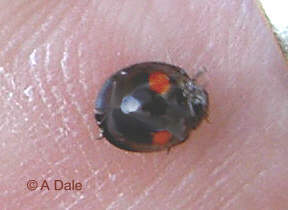

The distinctive features being that whereas the 2-spot is quite ovoid in shape, this one is more circular (a characteristic of the chilocorine group of ladybirds), and that the red spots are placed rather farther forward on the elytra than the 2-spot's centrally placed spots.
4 spot, Pine ladybird
Exochomus 4-pustulatus
The Pine ladybird is another small species, just a little over 4mm in overall length. So its dull red spots are not too easy to see against its black elytra. But the unique identifier for this species is the 'comma-like' shape of the two front spots.
Date
24.08.2007
Sighting
Found on garage wall underneath Horse Chestnut tree.

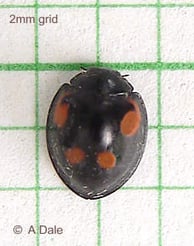
Although called the Pine ladybird (because it was initially identified preying on scale insects on pine trees) it is now recognised to prey on scale insects found on other trees as well. So it is just as likely to be found on Ash, Horse Chestnut, Sycamore and Lime trees.
7 Spot Ladybird
Coccinella septempunctata
Not quite the largest of the ladybirds at 8mm, but probably the best known.
It is universally known as the gardener's friend on account of the prodigious number of aphids it consumes, both in larval and adult form.
Date
24.04.2004
Sighting
Adult found on young nettles.
02.07.2004
Larva on rose bush by pondside in back garden.
03.08.2007
Adult seen in coarse hedgebottom vegetation.
01.04.2009
A few early larva found.
The female can lay up to 200 eggs. From birth the larvae predate on aphids and in their three week larval state will account for hundreds - and grow to some 13mm, much larger than the adult.
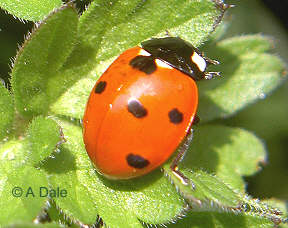

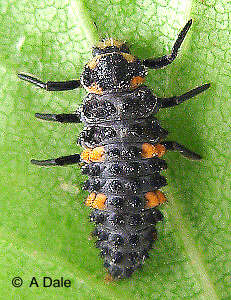

The adults hibernate over winter and become active from April onwards, depending on weather conditions. The resident UK population is also supplemented by migrants from the continent.
7 Spot, Adonis ladybird
Hippodamia variegata
The more one becomes aware of ladybirds, the more one realises that nothing should be taken for granted. As this one scuttled down the long grass stem, I assumed that it was a 2 Spot. Then I caught sight of another spot and, on close inspection, found that there were seven spots - all on a 5mm ladybird only about half the size of a 'normal' 7 Spot species.
Date
Sighting
01.08.2006
Found in long grass at base of hawthorn hedge.
15.08.2008
On Dog Rose growing in hawthorn hedge.
The other thing of note was that whereas the 'normal' 7 Spotter has an almost circular body shape, this one was rather 'shield' shaped with 6 spots displaced towards the rear.
But, before I could congratulate myself that I had identified another species, I discovered the significance of the 'variegata' tag in the scientific name. It seems that the 7 Spot Adonis can sport variants with between three and fifteen spots, which may merge or be discrete!
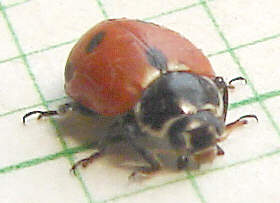


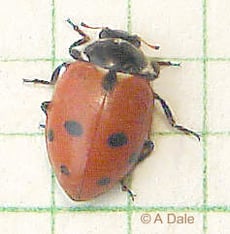
It is not widely distributed and is classified as 'localised' rather than 'common'. Like most ladybirds, it predates on aphids - but only on certain species of aphid. If it has to follow transient aphid populations this could well account for its localised habitats.
10 Spot Ladybird
Adalia 10-punctata
This can be a very variably marked species, though it seems that the top image is of one of the more common forms. It can range from this orange form all the way through to a brown version with orange spots.
Date
Sighting
08.06.2005
Found on a weeping willow.
12.06.2005
13 spot variation found at base of a damp Hawthorn hedge.
28.05.2010
10 spot found Siver Birch, Betula pendula.
And just to make life even more difficult, it does not always carry 10 spots. As the background colour varies, so some of the spots can merge with the background. And it can even live with 10+ spots as the lower image of a 13 spot variation shows. (The true 13 spot species, Hippodamia 13-punctata, is believed to be extinct in the UK.) This specimen had a pale skirt to the elytra and a whitish pronotum with black markings.
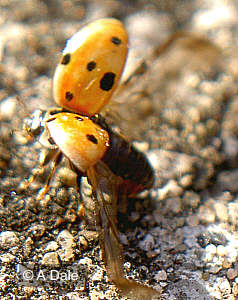

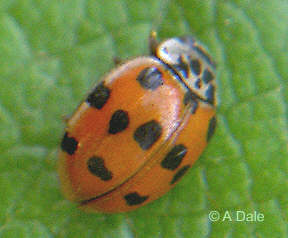

This species is much the same size as the 2 spot species ( 5mm ) with which it can sometimes be confused. But the defining feature appears to be that this species always has pale legs, whereas the 2 spot always has black legs.
The upper image caught the moment of lift-off, where the wing cases (elytra) open and the veins in the wings stretch the wings to their maximum area prior to flight.
11 Spot Ladybird
Coccinella undecimpunctata
This poor little critter seems to have a scorch mark on its wing case (maybe a spark from a chimney or a bonfire) which only serves to remind us that all living things can suffer accidents.
Date
23.10.2006
Sighting
Found in garden.

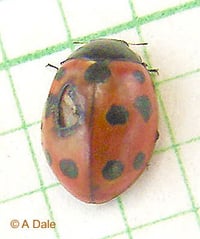
There are several ladybird species which are recognised to be 'variable' in the number of spots that they might have - and some can have 11 spots, but the size of this one, just over 5mm, it's oval shape and the distribution of spots appears consistent with the true Coccinella undecimpunctata.
It is a species that appears to favour coastal regions and in the UK is most commonly found in the SE England region.
14 Spot Ladybird
Propylea quattuordecimpunctata
There are some 43 different ladybird species to be found in the UK. At only 4mm in length, this common ladybird is only about half the size of the more familiar 7 spot ladybird.
Date
15.05.2004
Sighting
First of the season found on Blackthorn.
27.05.2005
One rescued from pond, one on Salix caprea.
28.05.2006
In long lush vegetation (grass, nettles, cow parsley) by roadside verge.
18.05.2007
On the fresh growth of young nettles.
It is quite shy and very active and quickly seeks cover should any dangerous camera get too close.
Its markings and colouring can be quite variable.
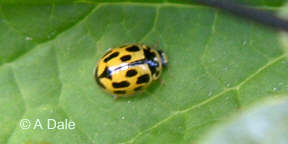

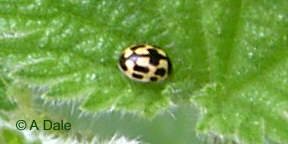

Since its diet is almost entirely of plant lice, it is found on many different plants, eg in my experience, blackthorn, salix, ribes and nettles.
or, thankfully, P. 14-punctata
25.08.2007
Two on Creeping thistle, Cirsium arvense.
15.08.2008
On Bramble.
14 spot, Cream spot ladybird
Calvia quattuordecimguttata
With 43 different ladybirds in the UK they can't all have different numbers of spots so this is 'another' 14 spotter. Same number of spots but different pattern and colouring.
Date
03.09.2012
Sighting
Found on Hawthorn hedge.


At 5mm (scaled against the 10mm plastic mesh) this one is slightly larger than the previous one.
18.06.2003
Found on blackcurrant bushes.
16 Spot Ladybird
Titthaspis sedecimpunctata
This is another tiny species, only 3mm long but, it taught me that one should never take anything for granted.
Date
20.05.2005
Sighting
Hay Meadow western hedge.
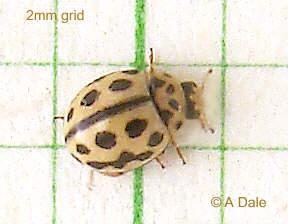

Having taken the picture, I was about to label it as 'just another 22 spot' (it is not too easy to count spots on a 3mm ladybird!) , when I noticed the continuous dark line down it's back - not a common ladybird feature. That made me take a closer look and then the merged spots became obvious. Plus the fact that it did not have 22 spots!
It favours damp regions and coastal areas.
03.06.2007
Found on garage wall.
16 Spot, Orange Ladybird
Halyzia sedecimguttata
Although this species is regarded as 'not common, very local', it appears to be extending its range and we may well be seeing more of it in future.
From an identification angle, the feature I found most intriguing was the apparently transparent flat 'skirt' all the way around the elytra (wing cases) and pronotum (upper shield covering the thorax).
Date
Sighting
25.03.2005
Found on a warm Spring day on a Viburnum tree, probably recently awakened from hibernation.
10.12.2005
4 found on bracken in Carmen Wood, Benniworth.
Overall length was 6mm with head tucked in and 7.5mm with head extended. The scale shown alongside the upper image is confusingly calibrated in sixteenths of an inch. Millimetres were on the other side!
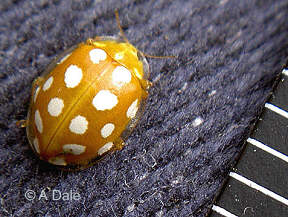



This particular specimen was found on a garden Viburnum tree, but the species is known to favour Sycamore and has been reported on Ash and Blackthorn, all of which are to be found locally.
Both the adult and the larvae feed on mildew.
22 Spot Ladybird
Pysllobora (Thea) 22punctata
Very small (3-4mm), and quite common throughout central and northern Europe.
Date
Sighting
19.09.2004
Found on Hedge Mustard on western side of Hay Meadow.
Their food source is - mildew! So they can be found on a wide range of vegetation - over-ripe fruits are favourite. This one was on Hedge Mustard which was indeed showing early signs of mildew attack.
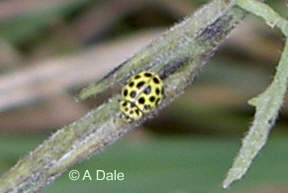


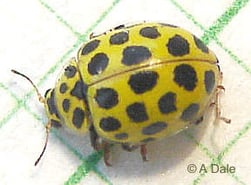
On something so small it can be quite difficult counting its spots and a side view is best. Only the spots on the elytra (wing cases) are counted. And in a species so wide ranging the colour and pattern is surprisingly consistent - although the small spot on the extreme outside edge of the elytra can sometimes be rather indistict.
14.08.2006
Found on long, coarse grass under a lichen covered wooden gate.
03.09.2007
Found on long, coarse grass on western side of Hay Meadow.
Harlequin ladybird
Harmonia axyridis
Date
19.07.2007
Sighting
Several pupae seen on riverside willow trees in Horncastle.


An increasingly common form has black wing cases with two red spots, each with a small white dot in the centre and is currently known as the 'Bullseye' form. The Harlequin is known to be interbreeding with native species so all sorts of hybrids may emerge to confuse things even more.
At 8mm in length, it is of comparable size to the 7-spot and Orange ladybirds. So any ladybird of that size which is not a 7-spot or an Orange ladybird could well be a Harlequin.
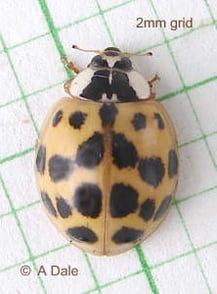

And the pupae, too, are quite unique. Although they tend to darken as they mature, they always retain the fringe of black and white bristles. And they are not difficult to find, being attached quite prominently on the upper surface of leaves with no attempt at camouflage.
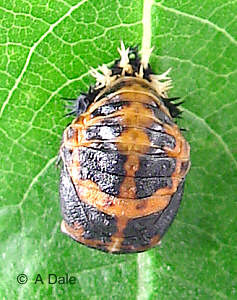

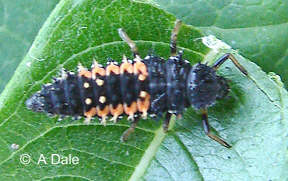

One of the Harlequin's less endearing features was demonstrated to me rather dramatically. I had two pupae on the same Willow leaf under observation. The first to emerge (the 19-spot example in the second image) promptly ate the second as it hatched! So, if they have cannabalistic tendencies towards their own species, there can be little doubt that they will not be averse to predating on native species as well - and there are fears that it may have a severe impact upon them.
Recognition of the larvae tends to be rather more straightforward. All the ones that I have seen appear to be consistent in shape and colouring. They can grow up to 9mm in length and are very distictively marked - no problem identifying these.
27.07.2007
Adult newly hatched from pupa.
04.09.2007
Several larvae found at same location.
First adult found at Low Hameringham.
07.11.2007
14.11.2007
Second adult found at Low Hameringham.
Adult found on garden Betula pendula (Weeping Birch).
01.04.2009
16.11.2007
Several pupae still on pruned back willows in Horncastle.
The Harlequin ladybird is of Asian origin, a recent immigrant - and capable of prodigious reproduction. It was originally confined to the south of the UK but is spreading relentlessly northwards. It appeared in my area of East Lincolnshire in July 2007.
Unfortunately, from an identification view point, the adult Harlequin, can have a variable number of spots. The most consistent feature to look out for is the distinctive black and white pronotum just in front of the wing cases. When seen lifesize it appears like a small dark 'M' against the white background.
